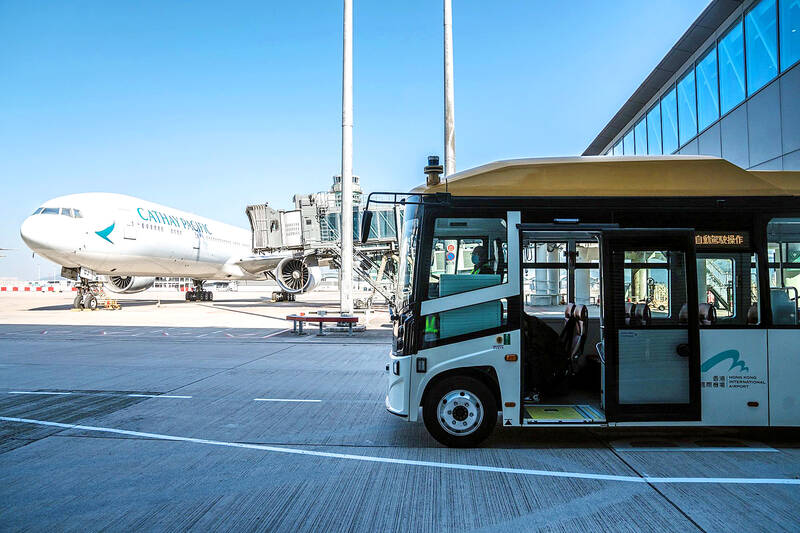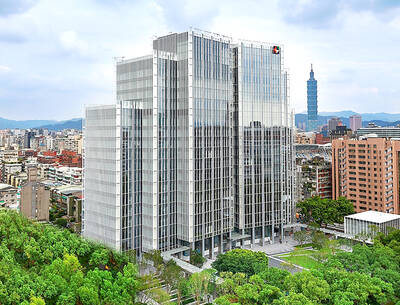Hong Kong’s goal to reclaim its spot as Asia’s premier financial hub is being tested by a scarcity of workers in the aviation industry, which is regarded as vital for re-establishing the territory’s international links.
The damage caused by years of closed borders is proving hard to undo. The number of workers employed at Hong Kong International Airport at the end of December last year was just 68 percent of the pre-COVID-19 pandemic level, the most recent figures provided by the Hong Kong Airport Authority showed.
Airlines are struggling to hire staff locally, prompting carriers to put off resuming routes shuttered during the pandemic.

Photo: Bloomberg
Qantas Airways Ltd delayed the restart of flights to Melbourne by three months to the middle of June because of a labor shortage at its contractor at Hong Kong International Airport, a person with knowledge of the matter said.
Labor constraints are also making it tough for local start-up Greater Bay Airlines (大灣區航空) to add flights from Hong Kong, chief executive officer Stanley Hui (許漢忠) told Bloomberg News this month.
Even the territory’s in-town check-in service has yet to reopen, another sign of the slow pace of recovery.
“The substantial loss of manpower is the crucial factor affecting the aviation industry,” said Perry Yiu (姚柏良), a Hong Kong lawmaker representing the tourism sector. “The shortage not only includes pilots, flight attendants and engineers, but also ground staff and grassroots workers.”
Worker shortages mean the territory faces a hard battle to get capacity back to levels last seen in 2020, when the airport was the world’s third-busiest in terms of international passenger volume, Hong Kong government data showed.
As of last month, air traffic movement was just 44 percent of the level four years earlier, while passenger numbers were 32 percent of that level, data provided by the Hong Kong Civil Aviation Department showed.
Compare that with London’s Heathrow Airport, at which air traffic and passenger volumes are more than 90 percent of pre-pandemic levels.
In Singapore, the numbers for both are about 77 percent.
“We are now lacking hands, we need to fill vacancies,” Board of Airline Representatives of Hong Kong vice chairwoman Yolanda Yu (于揚) said.
Like elsewhere during the pandemic, the territory’s aviation industry workers were let go as demand for flights plunged.
The workforce at Cathay Pacific Airways Ltd (國泰航空), the territory’s flagship carrier, fell about 40 percent to about 16,000 employees in the first half of last year from the end of 2019, its latest earnings report said.
Yet Hong Kong was far slower than other international travel hubs in lifting its COVID-19 restrictions, which were among the world’s most strict.
The territory only removed mandatory hotel quarantine for arrivals in September last year, while those visiting after that still faced regular testing and bans on eating in restaurants until late last year.
The lengthier curbs meant a greater impact on the local aviation industry, which also needs to compete with employers in services sectors in a tight labor market.
Since August 2018, Hong Kong’s workforce has dropped about 5 percent to 3.8 million people, the latest official figures showed.
Adding pressure is the ongoing exodus of residents. The population fell by 187,300, or 2.5 percent, to 7.33 million from the end of 2019 through last year. The territory’s workforce is also aging, while the birthrate in 2021 was the lowest on record going back to 1971.
The economy is also struggling, having shrunk in three of the past four years.
The government recognizes the problems facing the aviation industry, which is key to Hong Kong’s recovery.
The air transport sector and tourists arriving by air previously contributed about US$33 billion a year, accounting for about 10 percent of Hong Kong’s GDP, a 2018 report by the International Air Transport Association showed.
Hong Kong Secretary for Transport and Logistics Lam Sai-hung (林世雄) this month said that the government would work with the airport operator to quickly come up with measures to help with the worker shortage.
The territory is also looking at ways to alleviate the issue in the medium to long term, Hong Kong Financial Secretary Paul Chan (陳茂波) said in his annual budget address on Wednesday.
One solution being floated is to bring in workers from mainland China and give them special work permits to fill vacancies at the airport, people familiar with the discussion said.
This is a measure supported by Yu.
“I highly suggest the government consider reviewing” its labor policies or import workers from nearby regions of the mainland, Yu said.
Businesses are currently allowed to import workers to fill jobs they face “genuine difficulties” recruiting for locally, but the number is small, with just 3,000 low-skilled workers imported in 2021.
That was about 1 percent of the number of similar foreign workers that rival Singapore brought in to fill labor-intensive jobs such as construction, or other semi-skilled workers.
As for pilot shortages, carriers should focus on training staff locally, Lam told lawmakers on Feb. 15.
For now, airlines and passengers have to be patient.
“In Hong Kong we would love to operate two flights, one from Melbourne, one from Sydney,” Qantas chief executive officer Alan Joyce told the company’s half-year earnings media briefing. “They can’t handle that at the moment. So we have had to revert to one from Sydney.”
It might be a long road back to normalcy.
Cathay Pacific CEO Ronald Lam (林紹波) expects flight capacity to return to pre-COVID-19 levels by the end of next year, according to a Feb. 1 internal memo seen by Bloomberg News.
In the meantime, leisure and business travelers face the chance of ticket prices remaining elevated if demand rebounds, said Joanna Lu (陸佳佳), head of consultancy for Asia at aviation data firm Cirium.
“The recovery is unlikely to be sudden or frictionless,” she said.

UNCERTAINTY: Investors remain worried that trade negotiations with Washington could go poorly, given Trump’s inconsistency on tariffs in his second term, experts said The consumer confidence index this month fell for a ninth consecutive month to its lowest level in 13 months, as global trade uncertainties and tariff risks cloud Taiwan’s economic outlook, a survey released yesterday by National Central University found. The biggest decline came from the timing for stock investments, which plunged 11.82 points to 26.82, underscoring bleak investor confidence, it said. “Although the TAIEX reclaimed the 21,000-point mark after the US and China agreed to bury the hatchet for 90 days, investors remain worried that the situation would turn sour later,” said Dachrahn Wu (吳大任), director of the university’s Research Center for

Alchip Technologies Ltd (世芯), an application-specific integrated circuit (ASIC) designer specializing in artificial-intelligence (AI) chips, yesterday said that small-volume production of 3-nanometer (nm) chips for a key customer is on track to start by the end of this year, dismissing speculation about delays in producing advanced chips. As Alchip is transitioning from 7-nanometer and 5-nanometer process technology to 3 nanometers, investors and shareholders have been closely monitoring whether the company is navigating through such transition smoothly. “We are proceeding well in [building] this generation [of chips]. It appears to me that no revision will be required. We have achieved success in designing

PROJECTION: KGI Financial said that based on its foreign exchange exposure, a NT$0.1 increase in the New Taiwan dollar would negatively impact it by about NT$1.7 billion KGI Financial Holding Co (凱基金控) yesterday said its life insurance arm has increased hedging and adopted other moves to curb the impact of the local currency’s appreciation on its profitability. “It is difficult to accurately depict the hedging costs, which might vary from 7 percent to 40 percent in a single day,” KGI Life Insurance Co (凱基人壽) told an investors’ conference in Taipei. KGI Life, which underpinned 66 percent of the group’s total net income last year, has elevated hedging to 55 to 60 percent, while using a basket of currencies to manage currency volatility, the insurer said. As different

Taiwanese insurers are facing difficult questions about the damage of recent swings in the New Taiwan dollar. Regulators might have a partial solution: letting firms change how they calculate the value of foreign currency assets. The Financial Supervisory Commission (FSC) is considering allowing insurers to use six-month average exchange rates when they calculate risk-based capital in their semiannual reports, a shift from the current system where insurers use exchange rates on the final day of reporting. The change could ease pressure on the US$1.2 trillion insurance sector, whose huge exposure to foreign assets came into the spotlight earlier this month after a